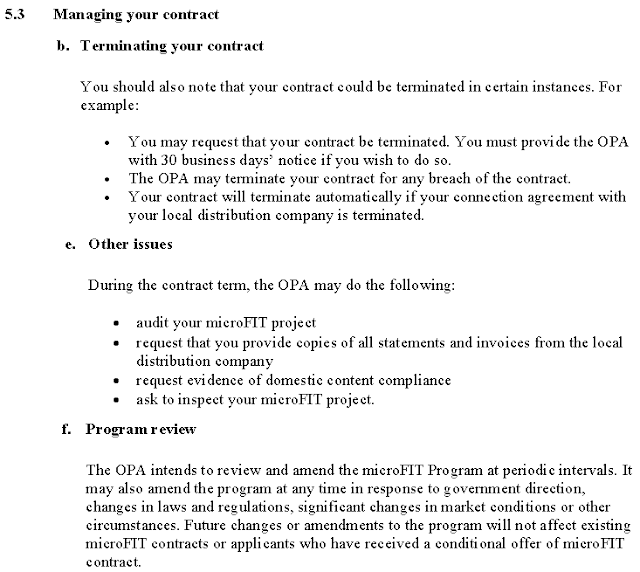Here are some FAQ's and their answers.
How many years for energy payback by a PV system to offset the energy used to produce the panel?
According to the German Solar Industry Association, it takes approximately 3 to 4 years for a photovoltaic installation to generate enough power to equal the amount of power it takes to manufacture the panels.
Are panels recyclable?
Although there is no formal recycling program in place for panels, parts of panels may be recycled separately where programs exist.
If no toxic materials are present in tempered glass panels, the glass can be recycled.
The aluminum frame is also recyclable.
Why shouldn’t I wait until prices of solar panels come down?
The rates of the microFIT program have been intentionally chosen to yield a reasonable return on investment.
As prices inevitably come down, those rates will be readjusted (for all new projects) to keep that same return when the pricing structure is reviewed every two years.
Therefore, there will never be a better economic situation than what we have today.
Why would the government pay 80.2 cents for solar power?
That price was set as the appropriate level to stimulate the solar energy industry, in order to create jobs and increase the renewable energy supply.
There are also cost advantages to a decentralized grid system (as compared to a centralized system dependent on nuclear or coal) as the power can be generated close to the demand sites.
What if the government changes and they cancel the FIT program?
All completed contracts are legally bound and would be honoured.
How do the domestic content requirements work?
To qualify for the premium rates of the microFIT program, all systems must incorporate a certain percentage of made in Ontario content.
There is a list of different activities and hardware with a corresponding percentage that add up to the threshold required.
Your installer will check off which of the activities where achieved by your project and provide written confirmation.
Be sure to read the entire rules on the OPA website before submitting an application or negotiating with a vendor.
Are all panels made the same?
No.
Like any product, there are different manufacturers and technological variances that will affect quality and price.
Do your research on the available options and seek out early adopters and industry experts for their expertise.
What type of warranty should I ask for?
Manufacturer warranties for solar panels are typically 20-25 years (conveniently the same time period as a microFIT contract), though the panels are known to last up to 40 years.
The inverters may have a shorter warranty of 5-10 years.
A minimum one year installation warranty is recommended.
Will my insurance company insure the panels?
The insurance industry is not unified in their approach to solar installations at this point.
Being seen as a business has implications that may not allow for coverage under existing homeowner policies.
Readers should consult with their insurance company before taking any steps in this guide.
What additional fees can I expect?
Additional fees may include:
• Local Distribution Company (LDC) costs:
- Connection fee (one-time),
- administration fee (one-time),
- account fee (monthly expense)
• Electrical Safety Authority (ESA) permit and inspection
• Building permit
• engineering designs, structural or building modifications
• insurance
• possible new government or regulatory requirements that are not currently in effect
Will the energy/revenue produced by my system be the same every year?
There will be minor variances from year to year.
You can also expect a slow decline in the output of the solar panels, on the order of 0.5% decline per year.
Will the MicroFIT income impact our charitable status?
No.
The microFIT program is no different than a church renting out its space.
A church that retrofits its church building to generate electricity is not running a business but using their facilities to further their purposes of their charitable entity and values.
Consult your accountant or Mennonite Foundation to confirm.
Faith Mennonite Church Solar Project
An informational blog to discuss the possiblity of installing a roof-top mounted solar panel system on Faith Mennonite Church in Leamington, ON.
Saturday, August 21, 2010
D.4. Important Documents
OPA's microFIT program also has these important documents:
Price Schedule - Revised August 13, 2010
Contract
Domestic Content
Rules - Revised July 2, 2010
Application Instructions - Revised September 30, 2009
Registration Instructions - Revised September 30, 2009
Sample of: Conditional Offer Contract
Pamphlet
Price Schedule - Revised August 13, 2010
Contract
Domestic Content
Rules - Revised July 2, 2010
Application Instructions - Revised September 30, 2009
Registration Instructions - Revised September 30, 2009
Sample of: Conditional Offer Contract
Pamphlet
Friday, August 20, 2010
D.3. An Overview of the MicroFIT Program
OPA has produced a 34-page overview of the microFIT program.
Below, I have highlighted the information that would pertain to our project.
Introduction

1. Learning About the MicroFIT Program
1.1.a Participation Opportunities - Owing Your Own Project
1.1.a Participation Opportunities - Chosing a Qualified Installer
Below, I have highlighted the information that would pertain to our project.
Introduction

1. Learning About the MicroFIT Program
1.1.a Participation Opportunities - Owing Your Own Project
1.1.a Participation Opportunities - Chosing a Qualified Installer
1.2 Overview of MicroFIT Rules and Contract
1.2.a. Overview of MicroFIT Rules and Contract - Project Eligibility Requirements
1.2.b. Overview of MicroFIT Rules and Contract - Rooftop Solar PV
1.2.d. Overview of MicroFIT Rules and Contract - Applicant Requirements
1.2.e. Overview of MicroFIT Rules and Contract - Prices and Length of the Contract Term
1.2.f. Overview of MicroFIT Rules and Contract-Domestic Content Requirements for Solar PV
1.2.g. Overview of MicroFIT Rules and Contract - Steps to Getting a Contract
5. Accepting Your Contract Offer
5.1. The MicroFIT Contract
5.1.a. The MicroFIT Contract - Start Date of the Contract
5.1.b. The MicroFIT Contract - Contract Price
5.2. Payment for Electricity Production
5.2.a. Payment for Electricity Production - Payments for Non-Incremental Projects
5.3. Managing Your Contract
D.2. FIT versus microFIT
The philosophy of each program remains the same – offering a guaranteed price structure for renewable energy projects.
However, small systems such as residential rooftop require different rules than large-scale projects like a wind farm, for obvious reasons.
The FIT program is designed for projects over 10 kW.
The MicroFIT program is designed for projects 10 kW and under.
MicroFIT is a green energy subsidy program developed by the Ontario Government with the Ontario Power Authority [OPA].
This program allows the opportunity to develop a very small or “micro” renewable electricity generation project on your property.
The MicroFIT program is based on a 20-year contract with the OPA.
Under the microFIT Program, you will be paid a guaranteed price [80.2¢] for every kilowatt-hour of solar electricity your project produces for at least 20 years and feed into the grid.
This is the program that would suit our church.
D.1. The Green Energy and Economy Act
On May 14, 2009 the Ontario government passed Bill 150, the Green Energy and Economy Act (GEA).
The purpose of GEA is to facilitate the development of a sustainable energy economy that protects the environment while streamlining the approvals process, mitigates climate change, engages communities and builds a world-class green industrial sector.
The centrepiece of GEA is the Feed-In Tariff [FIT] program.
- The first guaranteed pricing structure for renewable electricity production in North America.
- It offers stable prices under long-term contracts for energy generated from renewable sources.
- It is managed by the Ontario Power Authority.
- Help Ontario phase out coal-fired electricity generation by 2014 – the largest climate change initiative in Canada.
- Boost economic activity and the development of renewable energy technologies.
- Create new green industries and jobs.
This act is a significant departure from the large-scale, centralized power systems that have been dominant in the past decades.
- Switching from coal to renewable energy is significant in terms of climate change.
- It also marks a shift in who generates power and who benefits from that generation.
- Because renewable energy systems are smaller in nature, they have the opportunity to be community owned and managed – with the benefits brought to the entire community.
- How might our consumption of energy change if we had a direct hand in generating it?
- How can we ensure all members of the community, especially the marginalized, benefit from community-based energy systems?
What does Feed-In Tariff mean?
At its most basic, a Feed In Tariff (FiT) is a way to subsidize alternative energy until it is a viable enough energy source to “compete” on its own.
The definition for renewable energy sources being viable is called grid parity.
How the FIT Works
A FIT is a production incentive that pays a generator of renewable electricity a fixed rate for every kilowatt hour (kWh) of electricity that the generator produces over a 20 year period.
This differs from conventional generators whose compensation fluctuates with the Hourly Ontario Electricity Price (HOEP).
As a result, the FIT allows for much easier economic modelling of revenue for small projects, lowering development costs for these projects.
Even more important is the ability of a FIT contract holder to access capital.
A 20 year FIT contract, guaranteed by the entire Ontario rate base, significantly lowers risk for financial institutions and lowers the cost of borrowing.
Thursday, August 19, 2010
C.6. Property Requirements
A satellite view of our church's property:
Requirement # 1: South-Facing Rooftop
Every degree that a panel is not oriented to maximize exposure, will translate to losses in the productivity of a system.
However, a roof orientation from south-east to south-west will not see a significant decline in solar electricity production (approx. 5%).
There will be more of a reduction in power generation for east and west orientations (approx. 25%).
Our Property: The section of roof we are considering faces almost due south.
Conclusion: Our property meets this requirement.
Requirement # 2: An All-Daylight Unobstructed View of the Sun
To maximize exposure and productivity, a rooftop mounted solar energy system must have a visible and clear view of the sun during all daylight hours.
Our Property: The section of roof we are considering has a clear and unobstructed view of the sun all day long.
Conclusion: Our property meets this requirement.
Requirement # 3: An existing roof that will last at least 20 years.
What if my roof or shingles needs repairing?
You should do the repairs first.
It is possible to take off the panels and remount them, but at a measurable cost.
Why 20 years:
Conclusion: Our property will meet this requirement once the proposed shingling bulding fund project has been done.
Requirement # 1: South-Facing Rooftop
Even where a roof is not oriented to the sun, there may still be opportunities to mount panels on poles, racks or other equipment.
Every degree that a panel is not oriented to maximize exposure, will translate to losses in the productivity of a system.
However, a roof orientation from south-east to south-west will not see a significant decline in solar electricity production (approx. 5%).
There will be more of a reduction in power generation for east and west orientations (approx. 25%).
Our Property: The section of roof we are considering faces almost due south.
Conclusion: Our property meets this requirement.
Requirement # 2: An All-Daylight Unobstructed View of the Sun
To maximize exposure and productivity, a rooftop mounted solar energy system must have a visible and clear view of the sun during all daylight hours.
Our Property: The section of roof we are considering has a clear and unobstructed view of the sun all day long.
Conclusion: Our property meets this requirement.
Requirement # 3: An existing roof that will last at least 20 years.
What if my roof or shingles needs repairing?
You should do the repairs first.
It is possible to take off the panels and remount them, but at a measurable cost.
Why 20 years:
- the estimated serviceable life of the rooftop solar energy system.
- the guarantee period provided by the Ontario government.
Conclusion: Our property will meet this requirement once the proposed shingling bulding fund project has been done.
C.5. Maintenance and Weather
What are the maintenance requirements?
There is almost no maintenance required for a rooftop PV solar system.
Rain will keep the panels clean and there are no moving parts to break down.
How does weather affect the panels?
Panels are generally quite durable and built to resist the elements.
Hail should not have an impact on your system.
In the winter, the panels may get covered in snow.
The panels will heat up during daytime sunlight creating a water slick that will cause the snow to slide off the panels.
You may need to brush off the panels after a very heavy snowfall.
There is almost no maintenance required for a rooftop PV solar system.
Rain will keep the panels clean and there are no moving parts to break down.
How does weather affect the panels?
Panels are generally quite durable and built to resist the elements.
Hail should not have an impact on your system.
In the winter, the panels may get covered in snow.
The panels will heat up during daytime sunlight creating a water slick that will cause the snow to slide off the panels.
You may need to brush off the panels after a very heavy snowfall.
C.4. Does Ontario Get Enough Sun?
Yes!
The cold weather of Canada does not impact solar PV,
as it is the sunlight that generates electricity,
not heat
(in fact, warm temperatures lower efficiencies).
Ontario has better sun exposure than Germany
the world leader in solar energy,
and similar exposure as Miami, Florida over a full year.
As expected, there is some variation according to the region in Ontario:
Our community, aptly named the "Sun Parlour" has one of the highest solar potentials in Ontario.
The cold weather of Canada does not impact solar PV,
as it is the sunlight that generates electricity,
not heat
(in fact, warm temperatures lower efficiencies).
Ontario has better sun exposure than Germany
the world leader in solar energy,
and similar exposure as Miami, Florida over a full year.
As expected, there is some variation according to the region in Ontario:
Our community, aptly named the "Sun Parlour" has one of the highest solar potentials in Ontario.
Subscribe to:
Posts (Atom)
















































